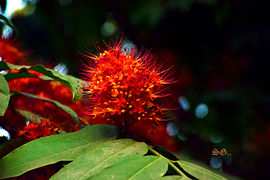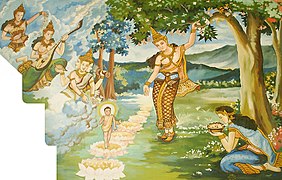Saraca asoca
| Ashoka tree | |
|---|---|

| |
| Ashoka flower cluster | |
| Scientific classification | |
| Kingdom: | Plantae |
| Clade: | Tracheophytes |
| Clade: | Angiosperms |
| Clade: | Eudicots |
| Clade: | Rosids |
| Order: | Fabales |
| Family: | Fabaceae |
| Genus: | Saraca |
| Species: | S. asoca
|
| Binomial name | |
| Saraca asoca | |
| Synonyms[2] | |
Saraca asoca,commonly known as theashoka tree(lit. "sorrow-less" ), is a plant belonging to theDetarioideaesubfamily of thelegumefamily.[3]It is an important tree in the cultural traditions of theIndian subcontinentand adjacent areas. It is sometimes incorrectly known asSaraca indica.[4]The flower of ashoka tree is the state flower of Indian state ofOdisha.[5]
Description
[edit]The ashoka is arain-foresttree. Its original distribution was in the central areas of theDeccan plateau,as well as the middle section of theWestern Ghatsin the western coastal zone of the Indian subcontinent.
The ashoka is prized for its beautiful foliage and fragrantflowers.It is a handsome, small, erectevergreentree, with deep green leaves growing in dense clusters.
Its flowering season is around February to April. The ashoka flowers come in heavy, lush bunches. They are bright orange-yellow in color, turning red before wilting.
As a wild tree, the ashoka is avulnerable species.It is becoming rarer in its natural habitat, but isolated wild ashoka trees are still to be found in the foothills of the central and easternHimalayas,in scattered locations of the northern plains of India as well as on the west coast of the subcontinent nearMumbai.[citation needed]
There are a few varieties of the ashoka tree. One variety is larger and highly spreading. The columnar varieties are common in cultivation.
-
Leaves and flowers inKolkata,West Bengal,India
-
Ashoka blossom
Mythology and tradition
[edit]The ashoka tree is considered sacred throughout the Indian subcontinent, especially inIndia,NepalandSri Lanka.This tree has manyfolklorical,religious and literary associations in the region. Highly valued as well for its handsome appearance and the color and abundance of itsflowers,the ashoka tree is often found in royal palace compounds and gardens as well as close to temples throughout India.[6]
The ashoka tree is closely associated with theyakshimythological beings. One of the recurring elements inIndian art,often found at gates of Buddhist and Hindu temples, is the sculpture of a yakshini with her foot on the trunk and her hands holding the branch of a flowering ashoka tree. As an artistic element, often the tree and the yakshi are subject to heavystylization.Some authors hold that the young girl at the foot of this tree is based on an ancienttree deityrelated tofertility.[7]
Yakshis under the ashoka tree were also important in early Buddhist monuments as a decorative element and are found in many ancient Buddhist archaeological sites. With the passing of the centuries the yakshi under the ashoka tree became a standard decorative element of HinduIndian sculptureand was integrated intoIndian temple architectureassalabhanjika,because there is often a confusion between the ashoka tree and thesaltree (Shorea robusta) in the ancient literature of theIndian subcontinent.[8]
InHinduismthe ashoka is considered a sacred tree. Not counting a multitude of local traditions connected to it, the ashoka tree is worshipped inChaitra,[9]a month of theHindu calendar.[9]It is also associated withKamadeva,the Hindu god of love, who included an ashoka blossom among the five flowers in his quiver, where ashoka represent seductive hypnosis.[10]Hence, the ashoka tree is often mentioned in classicalIndian religious and amorous poetry,having at least sixteen different names inSanskritreferring to the tree or its flowers.[11]
InMahākāvya,orIndian epic poetry,the ashoka tree is mentioned in theRamayanain reference to theAshoka Vatika(garden of ashoka trees) whereHanumanfirst meetsSita.
-
Dried ashoka flower (Saraca asoca) for selling in Kolkata market, India
-
Queen Māyā giving birth to the Buddha
-
Yakshi under a stylized ashoka tree. Railing figure atBharhutStupa, 2nd century BC, India.
Other trees called 'ashoka tree'
[edit]
A popular tree known as "false ashoka tree" or even as "ashoka tree",Polyalthia longifolia,is cultivated to resemble the growth pattern of erect pillar-like Mediterraneancypresstrees. It is a popular park and garden plant, much used in landscaping on the Indian subcontinent, known also asDevadaarorDebdaru.This tree can easily be distinguished by its simple leaves and very different flowers. Ashoka flowers are red (initially orange in color) whileP. longifoliaflowers are apple green in color. Ashoka fruits look like broad beans containing multiple seeds while false ashoka fruits are small, spherical and contain only one seed. Ashoka trees are small in height, while false ashoka is taller.
See also
[edit]References
[edit]- ^CAMP Workshops on Medicinal Plants, India (1998)."Saraca asoca".IUCN Red List of Threatened Species.1998:e.T34623A9879360.Retrieved2 June2023.
- ^ab"Saraca asoca (Roxb.) Willd. — The Plant List".The Plant List.5 January 2015.
- ^de la Estrella, Manuel; Forest, Félix; Klitgård, Bente; Lewis, Gwilym P.; Mackinder, Barbara A.; de Queiroz, Luciano P.; Wieringa, Jan J. & Bruneau, Anne (2018). "A new phylogeny-based tribal classification of subfamily Detarioideae, an early branching clade of florally diverse tropical arborescent legumes".Scientific Reports.8(1): 6884.Bibcode:2018NatSR...8.6884D.doi:10.1038/s41598-018-24687-3.PMC5932001.PMID29720687.
- ^Zuijderhoudt, G.F.P. (1968),"A revision of the genusSaracaL. — (Legum. Caes.) ",Blumea,15:413–425
- ^Orissa State Symbols
- ^"Herbs - Ashoka".Tamilnadu. 25 February 2013. Archived fromthe originalon August 14, 2013.
- ^Heinrich Zimmer,Myths and Symbols in Indian Art and Civilization.(1946)
- ^Buddhistische Bilderwelt: Hans Wolfgang Schumann,Ein ikonographisches Handbuch des Mahayana- und Tantrayana-Buddhismus.Eugen Diederichs Verlag. Cologne.ISBN978-3-424-00897-5
- ^ab"Ashoka Tree".Archived fromthe originalon 2011-07-11.Retrieved2009-03-30.
- ^Cowen, D. V. (1984).Flowering Trees and Shrubs in India, Sixth Edition.Bombay:THACKER and Co. Ltd. p. 5.
- ^Eckard Schleberger,Die indische Götterwelt. Gestalt, Ausdruck und SinnbildEugen Diederich Verlag. Cologne.ISBN3-424-00898-2,ISBN978-3-424-00898-2
Further reading
[edit]- Saha, Jayita; Gupta, Kamala; Gupta, Bhaskar (January 2015). "Phylogenetic analyses and evolutionary relationships of Saraca asoca with their allied taxa (Tribe-Detarieae) based on the chloroplast matK gene".Journal of Plant Biochemistry and Biotechnology.24(1): 65–74.doi:10.1007/s13562-013-0237-3.S2CID18464425.
External links
[edit] Media related toSaraca asocaat Wikimedia Commons
Media related toSaraca asocaat Wikimedia Commons






